Table of Contents
We gathered the top Kickstarter campaigns of all time to better demonstrate what you can do with a Kickstarter campaign. Have a look today!
By reviewing the most successful Kickstarter projects, we will hone in on the top strategies to emulate for your project.
Pebble Time
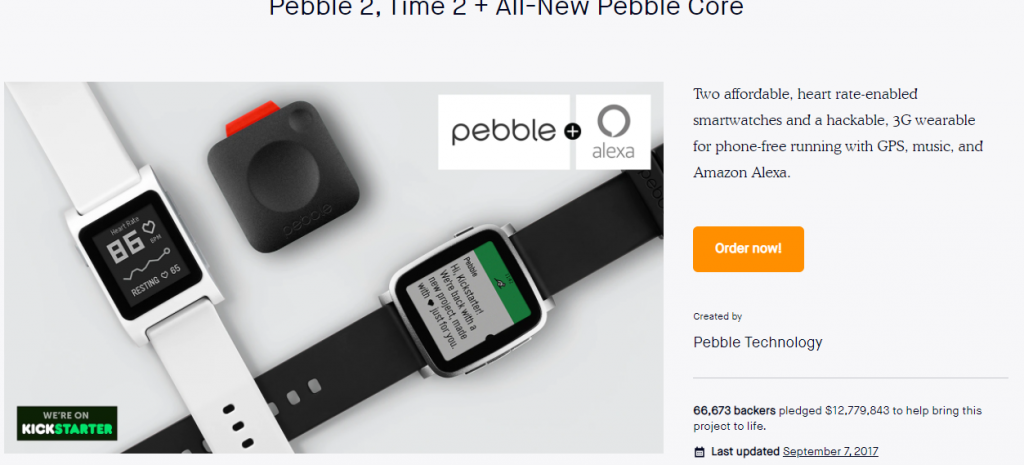
Goal: $500,000
Amount Raised: $20,338,986
Kickstarter was the largest crowdfunding project of all time when it debuted. Advances in technology and devices that were becoming attractive were on the rise. In the spring of 2012, Pebble raised USD 10 million in their first crowdfunding campaign, and in the fall of 2014, they raised USD 10.25 million through a second crowdfunding campaign. During the early part of 2015, it appeared as though Pebble had all but secured the market for smartwatches. Pebble was bought by Fitbit two years after piling up $23 million in debt.
Why It Was Successful
- Migicovsky, the creator, was able to garner US$375,000 in angel funding from prominent angel investors, including Tim Draper of Draper Fisher Jurvetson. Though the sum was substantial, Migicovsky was able to sell hundreds of Pebble Technology watches to Blackberry.
- To generate extra money, Migicovsky set a funding goal of $100,000 on the Kickstarter site and placed the device up for sale.
- It planned to give a substantial discount on the $150 smartwatches for the first 200 pre-orders through the Kickstarter campaign. The objective was reached, and only in two hours, and ultimately, the Kickstarter was shut down after raising $10,266,845.
- At the beginning of 2013, the firm signed a deal with Foxlink Grou to manufacture 85,000 watches and then sent the completed timepieces to the consumers who had funded the Kickstarter project.
- Two years after offering him $740 million for his firm, Citizen, an 86-year-old Japanese watchmaker, gave Migicovsky the chance to acquire the business but he declined, confident in the company’s future.
- Despite Apple posing the greatest danger to Pebble’s chances of success, Migicovsky introduced innovations including tracking the health, which is done with the help of the watch.
Coolest Cooler
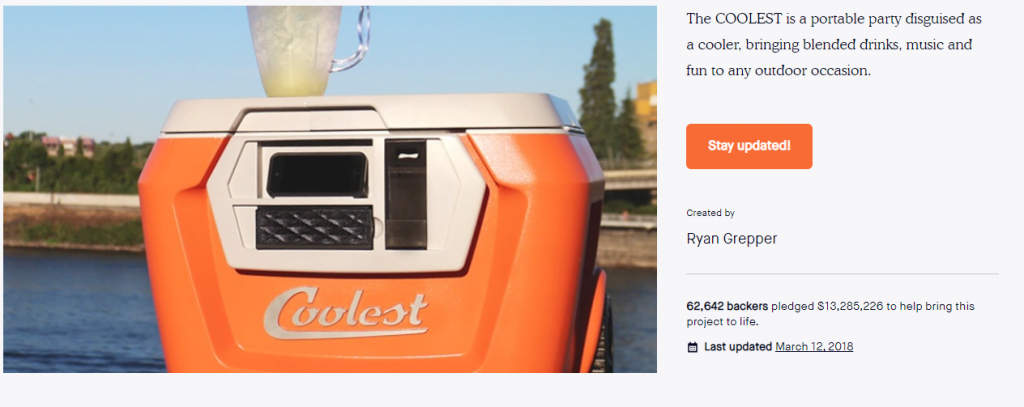
Goal: $50,000
Amount Raised: $13,285,226
You don’t find many businesses that are still in operation on this list. This Kickstarter campaign raised the second most money on record for a Kickstarter project, with Coolest Cooler turning it into a profitable business. The price of the cooler is down to $187.99, having gone up to $249.99 previously. You will pay $299.99 for a fully loaded blender, LED lid light, and battery USB charger if you want them included. This cooler was presumably built with parties in mind, and thus it’s the finest of the products listed here. No one will want to leave when you use this to keep your drink cool and your waterproof Bluetooth speaker to keep the party going.
Why It Was Successful
- According to the company’s creator, Ryan Grepper, this cooler is “the ultimate portable party.” This marketing strategy helped boost sales among Millenials.
- Ryan takes it upon himself to assume personal accountability to every one of his backers, and he is dedicated to ensuring the Coolest attain its goal.
- July launching, additional backers, and an updated design were all key to raising considerably more than his target of $50,000.
- Maintaining such modest expectations and achieving them within 36 hours of the debut has helped him gain an advantage in the manufacturing department.
The World’s Best Travel Jacket
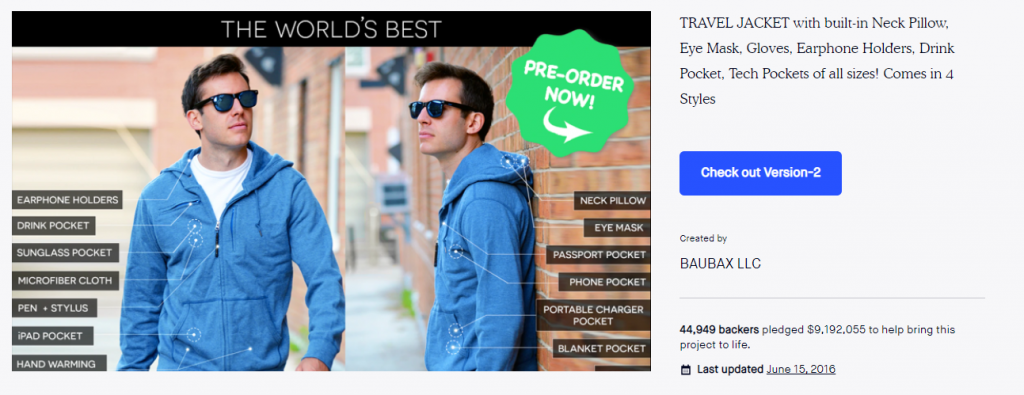
Goal: $500,000
Amount Raised: $12,143,435
The BauBax jacket is, the most-funded apparel project ever on Kickstarter, at the time of this writing in 2019. The jacket’s built-in neck cushion is one of its most remarkable features. Additionally, this latest garment includes over 20 distinct characteristics and can be purchased in three different styles: a sleeveless vest, windbreaker, and sweatshirt. It comes with bands particularly designed for your Airpods Pro as well. There have been increases in pricing since 2016, and the price range can span from $157 to $199.
Competitor #2 also made the most backed jacket in the campaign. At the time of this writing, Baubax has earned the highest money for a pair of trousers from the Indiegogo platform. A new crowdfunding campaign is launched for the very greatest pair of travel trousers that you will ever own (according to them). Here you may have a look.
Why It Was Successful
- The travel Jacket offers four distinct designs, with several concealed features that help to make getting around easier and hands-free.
- The gadgets that you find within the neck pillow are capable of inflating it in two seconds, there are cupholder pockets that are completely insulated, and gloves are tucked in each sleeve.
- In the beginning, the jacket seems like any other ordinary article of apparel. All of the technologies are hidden beneath the surface, waiting to assist you with your travel needs.
- When it comes to airport security, this device is notably convenient.
- In simple terms, their test connected with a larger audience when they asked the question, “Should we just place this catch-all item on the conveyor belt, rather than dumping everything in your pockets, iPad covers, etc?”
Snapmaker 2.0 Modular 3-in-1 3D Printer
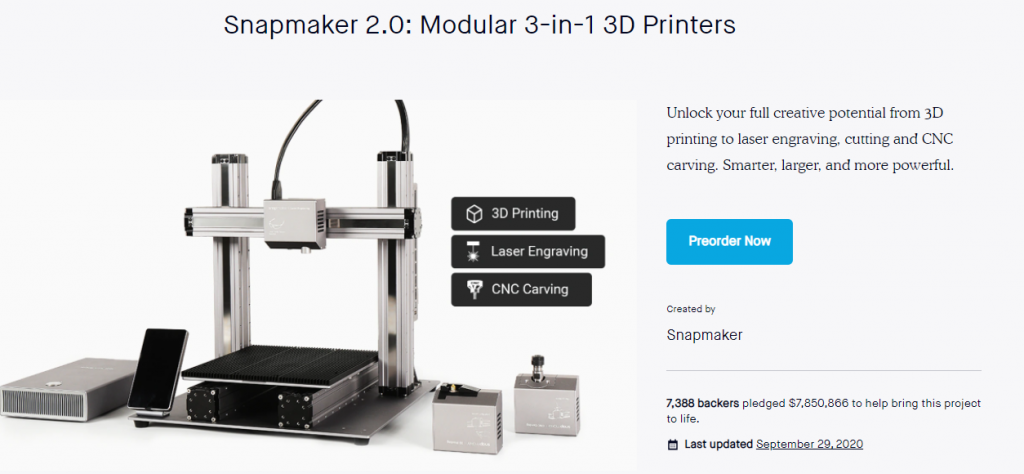
Goal: $100,000
Amount Raised: $7,850,866
Snapmaker began in 2017 with a $2.2 million Kickstarter, and they were the third most successful Kickstarter initiative within the 3D printing industry. Snapmaker has moved up to eleventh place in our list of the most successful Kickstarter projects of all time.
Snapmaker 2.0 integrates 3D printing with additive manufacturing (3D printing + AM) which includes laser engraving and CNC milling. In larger machine shops, these often operate as three distinct and costly equipment. The unique feature of this machine is that it works with a wide range of machine-shop materials such as metals, plastic, wood, and acrylic with the option to work with just about any of these materials from a single control computer. It unites all the machine’s related problems, which makes it easy for brand new consumers to enter the market.
Snapmaker’s website sells the most costly model for $1,199. This product is priced within the range of an amateur’s budget.
Why it was Successful
- The Snapmaker sold successfully due to its sturdy, all-metal chassis, as well as its ability to be constructed easily and at a reasonable price.
- Before the release of the Snapmaker, no major rivals had entered the market at the same cost. That is much more relevant now.
- A goal of Snapmaker is to help the DIY (do-it-yourself) market obtain low-cost multitool 3D printers.
- The Snapmaker 2.0 series of machines aims to be smarter, quicker, bigger, and more efficient than any previous machine the company has produced.
- A large part of quality assurance also relates to defining the machine’s delivery schedule as well as guaranteeing the quality of the equipment.
- Greater delivery. In their organization, the production team has come a long way. Snapmaker’s prediction of production 3 – 6 months is now more accurate, and it can also anticipate and modifies supply to meet demand a month earlier.
Exploding Kittens
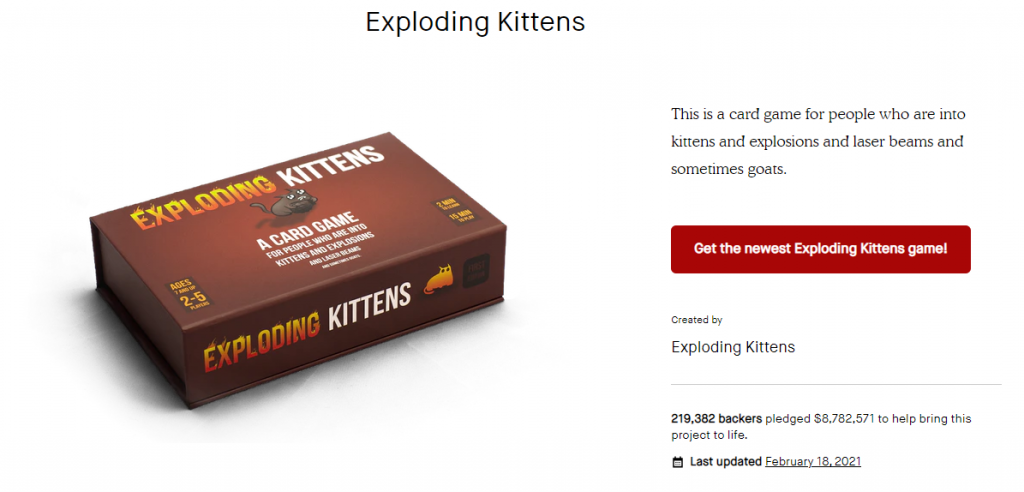
Goal: $10,000
Amount Raised: $8,782,571
In comparison to other card games, Exploding Kittens is an extremely strategic game of Russian Roulette. In the game Exploding Kittens, each player takes turns picking cards until somebody draws an exploding kitten, and the game is lost for all participants. Cards that enable you to look at your cards to escape exploding or to force your competitor to draw several cards are part of the deck.
As you go farther into the game, you’ll find that the stakes grow more and higher as you are less likely to get the kitten (the card that has “doing adorable things”) and to explode in a flaming ball of catty exaggeration (the side effect of exploding).
Why it was Successful
- In addition to simple ideas, clever execution, and a record-breaking Kickstarter, Exploding Kittens had already occurred when I first said this. Using it in the hopes that the creators would convene and try it out. This game is simple to learn, yet the challenge is set up so it will be able to connect with anybody to the finish.
- In addition to being funny, the game designers also exhibit a collaborative attitude. And to my knowledge, one of Spiro’s clients, the developers of Cards Against Humanity, has offered to assist aid the Exploding Kittens ship orders, as well as satisfy their fulfillment requirements, through their distribution facilities.
- The partnership is another important factor behind Exploding Kittens’ success. While each of the three people who created Exploding Kittens is widely recognized in the entertainment business, they aren’t members of the same creative team.
Potato Salad

Goal: $10,000
Amount Raised: $55,492
Founded by Columbus, Ohio native Zack Brown, his Potato Salad Kickstarter campaign seeks to gather funds only to create potato salad, which is a satirical take on the traditional crowdsourcing model. The Kickstarter campaign for Brown’s idea immediately exceeded its $10 target and went on to earn upwards of $50,000 in less than a week, despite the complete absence of basic information and practical specifics about the project.
Brown set a $10 target and an end date of August 2nd, 2014 for the campaign. Backers who donated at least $1 got Brown to mention their name while cooking potato salad; those who donated at least $3 got a taste of the potato salad.
The boiling potato meal is believed to have originated in Europe, with numerous diverse variants found in different areas, including Croatia, the Czech Republic, Germany, Italia, Romania, and Syria, all of which have their unique variations.
Why it was Successful
- The causes are doing better than expected. This one-off triumph with potato salad shouldn’t dampen your excitement about fundraising, online crowdfunding, the Internet, and the human race. As businesses, teams, or individuals, we may be involved in some of the most memorable experiences through causes.
- Don’t Be Too Serious With Yourself. Never underestimate the impact of irony, wit, or sarcasm while communicating online. Buzzfeed, for example, and other internet behemoths like it were founded on it. Others said they backed the idea because the absurdity of crowdsourcing potato salad made them laugh. Even the most sensitive matters may benefit from a lighthearted approach to better engage their audience.
- Be Open and Honest with Others. Backers didn’t appear to care about the utter absurdity of supporting someone’s debut as a potato salad chef. It was important to supporters that Zack “Danger” Brown seemed sincere and open about his goals and motivations. Goal: “Basically, I’m simply going to make potato salad,” he says. I’m not sure what kind I want yet.
Kingdom Death: Monster 1.5

Goal: $100,000
Amount Raised: $12,393,139
Adam Poots, the developer of Kingdom Death: Monster 1.5, is no stranger to the world of crowdsourcing. He started a Kickstarter campaign in 2009 to create a figure he dubbed The Foresaker. 38 supporters together contributed $1,741. In 2009, he made a second effort at crowdsourcing for the Kingdom Death iPhone app. While Adam Poots claims it was a failure, the project nevertheless managed to gather $2,049,721 from a whopping 5,410 donors.
It was originally funded through Kickstarter in 2015, however, you may now buy the improved version. We’ll come back to exploding kittens, which was the most funded Kickstarter game when the project initially began. More than four million dollars have been won since then over exploding kittens.
Why it was Successful
- Many fans predicted the campaign to take a more traditional route, unveiling additional material and stretch goals when money-milestones were reached, but Adam and Anna Poots chose a different, entertainment-driven strategy to the campaign following the tremendous first fundraising surge.
- We wanted to provide the community more opportunities to discover and access new content than just setting a limit on how much money they could spend on subscriptions.
- Even while this strategy didn’t go down well with some people, it fascinated others, who watched with eager anticipation to see where the campaign would go next and what new information would be released.
- Kingdom Death: Monster 1.5 is now the third most well-funded project on the crowdfunding website Kickstarter.
- All hopes were shattered when Kingdom Death: Monster 1.5 raised $9 million on the online crowdsourcing platform Kickstarter.
- According to JustNerd.en, Kingdom Death: Monster 1.5 is the most successful board game ever on Kickstarter in Japan.
Tiers of rewards have been set up by Kingdom Death for its crowd sale backers, such as
- For $200, you can get a Black Friday Lantern that includes the whole 1.5 core game. Shipping is not included in this cost.
- Lantern made of gold costs $350. Kingdom Death: Monster Core 1.5 and the Gamblers Chest are included in the price of this prize level. The cost of delivery is not included.
- Lantern made of ancient gold, priced at $750. Obtaining all existing expansions like Dragon
- King and Flower Knight is included in this prize. Kingdom Death’s shipping costs are not included in this pricing.
- The day after Thanksgiving is called Black Friday. The Gambler’s Lantern is available for $777 at this time. Kingdom Death Update Pack, Gambler’s Chest, Gambler T-Shirt, and any new expansions, pinups, and promotions for this Kickstarter campaign are all included in the price of this reward level.
- For $1,666 you can own Satan’s Lantern. When it comes to the Kingdom Death Kickstarter, the final price includes everything from the base game to the current expansions and a Satan
- T-Shirt to Series 1 of the Pinups of Death. The cost of delivery is not included.
Travel Tripod by Peak Design

Goal: $500,000
Amount Raised: $12,143,435
Peak Design’s unique ball head is included with the five-section Travel Tripod, which comes in either aluminum or fiberglass. Peak Design has initiated a Kickstarter campaign for the tripod today, with an aluminum version priced at $349.95 and a carbon fiber variant priced at $599.95. Retailers should receive it in time for the holiday shopping season.
The Travel Tripod, like many of Peak Design’s other popular camera accessories, is packed with nifty design and technical features. Because it’s lightweight and tiny enough to fit in the side pockets of several Peak Design backpacks, the tripod is ideal for travel. Compared to previous alternatives, this tripod is much thinner when closed (around the width of a soda can).
Peak Design began in 2010 when Peter returned from a three-month global tour. He learned the hard way that taking a DSLR camera on a trip isn’t too much fun. DSLR cameras provide stunning results, but they require the user to constantly carry about a 2-pound, strangely shaped gadget.
A solid camera holder that can hold any DSLR was born when Peter got home and began working on it right away. The result was the Peak Design Capture Camera Clip. At the time of his debut, he had already raised $364,698 from 5,258 supporters on Kickstarter.
Why it was Successful
- It’s safe to say that Peak Design is no stranger to the world of crowdsourcing campaigns. This is the company’s eighth successful Kickstarter campaign.
- In terms of product innovation and marketing, the Peak Design Travel Tripod is a shining example. Consequently, the total has now reached eleven million dollars while continuing to rise.
- Seeing that the campaign was so successful, Peak Design has recently released a modification dubbed Ultralight conversion kit, which converts the travel tripod into a minimalistic, ultralight hiking tripod.
- Before the Travel Tripod, Peak Design completed and executed crowdfunded projects.
- Peak Design appears an astonishing four times in a list of the top 12 most-funded design projects on Kickstarter. Since its inception, they’ve successfully delivered to more than 110,000 supporters, raising over $20 million from all of their projects together. They are, without a doubt, one of the most prolific crowdfunders ever.
- peakdesign.com has grown to be an industry leader when it comes to the creation of camera bags and other photography accessories. They’re always coming up with new, creative, and useful goods for their ever-expanding audience.
- Peak Design uses BackerKit’s pledge management system and professional customer care for all of their backer administration needs because of their large number of backers.
- Peak Design’s fulfillment was streamlined thanks to BackerKit’s pledge management capabilities, which freed up company resources to focus on production. Information manipulation, bulk processing of backers, and precise data collection via Backer Surveys have all contributed to the acceleration of operations.
- They placed their faith in BackerKit to not only look after their burgeoning community but also to uphold and contribute to their good name.
Critical Role: The Legend of Vox Machina Animated Special

Goal: $750,000
Amount Raised: $11,385,449
You’re probably wondering, “What the heck is Critical Role?” The crucial role appears to be a weekly live broadcast tabletop role-playing game with well-renowned voice actors, according to their Kickstarter campaign. The 115-episode original series ended in 2017 and included a plot about the Vox Machina crew of intrepid explorers.
Because the live stream was so popular, they wanted to adapt their tale into an animated series, which sparked the creation of this Kickstarter campaign. This project became the 5th most-backed Kickstarter project ever because of Critical Role’s very dedicated fan following, which helped them surpass their original funding target by moreover 10 million dollars. The animated series is scheduled to premiere in 2020.
Why it was Successful
- To support “The Legend of Vox Machina” Kickstarter, Critical Role fans collected more than $11.3 million.
- A whopping 88,000 individuals chipped in to make this campaign possible.
- “Critical Role” produced a 10-episode cartoon series rather than a 20-minute special.
- Titmouse, the production firm behind Netflix’s “Big Mouth,” produced the show, which was written by Jennifer Muro (of “Star Wars: Forces of Destiny” fame). The show was due to premiere in the fall of 2020, according to the original release date.
- Critical Role may be the greatest instance of ‘actual play’ D&D, when a circle of friends get together and broadcast their dice-rolling escapades at the table, hosted by a variety of renowned American voice actors and with a flourishing worldwide fan following.
- Fans of Critical Role, often known as “Critters,” have encouraged the team to publish books and comics, organize live events, and now an animated film based on the brand.
OUYA

Goal: $950,000
Amount Raised: $8,596,474
When OUYA launched on Kickstarter in 2012, it had the second-highest funding total of any project in its history. There aren’t many people who know about it now that it’s slipped to position #9.
Razer Inc. purchased the company’s software assets when it was divided up. Razer officially ceased supporting the OUYA console in June of this year. On the other hand, according to Tech Crunch, the company struggled to recruit researchers to focus on the OUYA platform.
OUYA was a $99 Android-based game system for televisions. It had a ton of games to choose from, and they were all free to check out. OUYA’s open architecture allowed developers to create videogames for the lounge room that make use of all the features a TV has to deliver.
Why it was Successful
- If you want an Ouya system, you may have one for as little as $99 if you donate to the Ouya Kickstarter campaign. Even compared to current console prices, that’s a better value than most mobile game consoles. There is no denying that the Ouya system is outclassed by current-generation consoles such as the Xbox 360 and PS3 in terms of raw power. Despite the absence of a specialized graphics card, most gamers won’t mind using the Ouya with their HDTV and sound system. Openness on the Android platform is leveraged to make it easier for users to create and enjoy games, all while keeping costs down.
- The Ouya console can be altered, enhanced, or “hacked” with minimum effort. Let’s face it: tech fanatics adore moddable devices. Many gamers have shown an interest in tinkering with the Ouya system, and the company behind it is determined to making the console as “open” as possible so that anybody may do so.
- Those who have tried to update an Xbox 360’s hard drive know that you have to either pay for a costly Microsoft-branded drive or try to change your Xbox 360’s hard drive yourself, thus this is a major selling factor. Using proprietary hardware or peripherals (such as Sony’s outrageously overpriced PlayStation Vita memory cards), many manufacturers impede our attempts to repair or update the products we own.
- The creators of Ouya are banking on gamers’ dissatisfaction to drive sales of their devices. Users should be able to upgrade or repair their Ouya with classic PC components (hard drives, RAM, etc.) when the console launches in March next year, as well as purchase and configure fascinating peripherals from third-party manufacturers, and publicly release their games to the Ouya service without having to pay licensing fees.
- Yves Behar, the designer who worked on the Jambox, helped build the Ouya prototype, which looks great on your shelf. You can also see it in action on the Kickstarter website. It’s easy to dismiss Apple’s focus on hardware design and aesthetics, but it’s a key reason for the company’s success, and the Ouya console is following the same path. Spending money on something that will be displayed in your living room next to your HDTV for several years means you want it to look good.
- Besides looking amazing, the Ouya controller fixes a couple of long-standing issues with Android gaming. There is no viable method to recreate the sophisticated control choices provided by a gamepad and analog buttons on a touchscreen device, which is one of the most irritating features of Android games. It’ll be fascinating to discover what kinds of games are available for the Ouya once it releases in March of next year since the Ouya platform promises to alter that. Even if the premier games aren’t that good, any Android developer can publish an app for Ouya, which means early adopters will certainly be able to add one more Netflix device to their household entertainment center.
The 7th Continent

Goal: $40,000
Amount Raised: $7,072,757
The first Kickstarter project from outside the United States makes the cut this time around, hailing from France. In The 7th Continent, you take on the role of the hero in an action card game. The game supports up to four players and the money raised was for an additional card set titled ‘What Goes Up, Must Come Down,’ which allows you to take on the role of the hero in two different situations or “curses” and see if you can make it through.
A Kickstarter by the game’s developers explains that because it’s so expensive to create, there’s no way for the game to be sold in shops. Whatever the case may be, The 7th Continent has a devoted following around the globe.
Why it was Successful
- For the first time in the history of board games, this one will need you to spend countless hours traveling and investigating the whole seventh continent before you find a way to erase any of the curses.
- The 7th Continent has a built-in saving mechanism, so you may stop playing whenever you choose and pick up where you left off when you return.
The Everyday Backpack, Tote

Goal: $500,000
Amount Raised: $6,565,782
It’s fair to say that photographers are the most forward-thinking of any other discipline. The inclusion of two photography items on this list reflects this reality. Photographers are eager to attempt just about anything that makes their jobs easier or more comfortable. Just two years ago, this Kickstarter campaign was the 10th most financed in the history of the platform. As expected, the new #10 comes from the same manufacturer!
Designed for photographers in need of a fresh way to transport all of their gear, this backpack came in handy. As a result of their dominance in the photographic sector, Peak Design has perfected the crowdfunding model. Their enthusiasm is contagious, and it’s clear that they’re committed to bringing only the greatest goods to market.
Why it was Successful
- Peak Design chose the other extreme, establishing a business in plain view of its target market and its rivals.
- When compared to the other Kickstarter top-funded initiatives, Peak Design stands out. When compared to other companies in its industry, the firm has opted not to accept external investment — and this is not because no offers have been made.
- The bag’s features were tailored specifically for photographers, such as partitions and fast access spots. And that was also done on purpose: it’s more than a camera bag. Because it’s called the Everyday Messenger bag, you know it’s going to be useful every single day.
- It was created and promoted to meet the requirements of a wide range of people.
- The firm had to shift gears after a campaign so massive it overshadowed anything else they’d done. It began spending significantly more time with its Vietnamese suppliers.
- Since its Kickstarter campaign began, the firm has supplied almost 1,800 of the devices, earning nearly $261,000 from just that one product.
- Peak Design established its footing during its Kickstarter campaigns and kept releasing better and better photographic gear. In addition to the $820,000 committed for the Capture Clip v2, which is an upgraded version of the original Capture product, $860,000 in pre-orders were received for the company’s camera strap and handgrip.
- Its last campaign, the fifth, found the sweet spot with a camera bag that was also excellent for non-photographers and brought in $4.9 million from 17,000 supporters, making it a huge success for the firm.
Fidget Cube

Goal: $15,000
Amount Raised: $6,465,690
Fidget cube has a fascinating backstory. Antsy Labs, the company behind the Fidget Cube, failed to meet its target by 43,000%. Although I’d like to think I’m making that up, we performed the math! Indeed, they weren’t ready for the kind of demand that their concept would generate.
There was a tight deadline of Christmas 2016 for getting the goods made and shipped to supporters, however, the team ran into problems with the manufacturer in China. Because of this, Polygon had to notify all 154,926 of its supporters to let them know their orders wouldn’t be sent in time for Christmas.
Antsy Labs refused to compensate their Chinese supplier for the faulty product. Antsy Labs. As a result, a Chinese firm was left with millions of faulty items and no customers. Unfortunately, before Antsy Labs could produce their final product, the factory chose to dominate the global market with subpar counterfeit fidget cubes. In my opinion, Antsy Labs made a blunder.
In the end, Antsy Labs produced their items and sent them to their supporters, but not before they had to deal with a few difficulties. The fidget cubes are available in a variety of shapes, colors, and combinations thanks to Antsy Labs’ expanded product range.
Why it was Successful
- As a result of their expertise, Jack and his colleagues were able to pivot fast and use WordPress and its eCommerce plugin WooComerce to debut their Anxiety Cube site by the end of December.
- They invested less than $5,000 in start-up expenditures, mostly on a large purchase of 2,000 plastic cubes for $3.65 each. The idea was to resell them for $19.99 a piece.
- This time, they made use of FollowLiker, a program that automates the process of increasing a user’s following and spreading awareness about a business.
- Approximately 100 Stress Cubes were sold each day in the first week of business. They were selling around 800 a day at their height. They had no other choice than to hire contractors to deal with the volume of shipments and rent an office space that was 400 square feet.
- To keep up with demand, Jack and his two business partners ordered 15,000 Stress Cubes, wiring $70,000 to a manufacturer in Shenzhen without guarantee or any assurance that the product would arrive on time.
- The Fidget Cube was created to keep your fingers occupied without being distracting and to be taken around with you wherever you go. This campaign’s rapid growth may be due in part to its simplicity.
- According to Mark McLachlan, CEO of Antsy Labs, “the reason this is connecting with so many people is that fidgeting is a highly human activity.” To make Fidget Cube a helpful tool for anybody, whether a scholar or an administrator, “we were very purposeful in our design approach.”
Shenmue 3

Goal: $2,000,000
Amount Raised: $6,333,295
14 years after the release of Shenmue 2, the game’s developers decided to start a Kickstarter effort to raise funds for a follow-up game. Shenmue is among the first video games to take advantage of the “open-world” concept, in which players were free to go in any direction and make their own decisions about their adventure. In this immersive coming-of-age narrative, the central character Ryo Hazuki journeys from Japan to China in search of vengeance for his father who was killed in a war. Along the way, he meets new people, gets himself into some trouble, and, most importantly, achieves his Kung-Fu training course.
Finally, funding for Shenmue III has been secured after years of passionate fan campaigns and disappointed expectations. An iconic action-adventure game series’ third entry has completed its Kickstarter campaign, raising slightly over $6.3 million from almost 70,000 supporters. The game was initially created for the Sega Dreamcast system.
The long-awaited sequel, designed by famous game creator Yu Suzuki and overseen by him, has surpassed the previous record-holder Bloodstained: Ritual of the Night by over a million dollars on the Kickstarter site. Shenmue III also broke the $1 million funding barrier the fastest, doing it in just under 2 hours after the Kickstarter campaign went live. Within nine hours of release, the game had surpassed its $2 million funding goal.
Why it was Succesful
- The game is being created by Shinjuku-based company Neilo, which was responsible for the quirky PlayStation rhythm action role-playing game Orgarhythm, with Yu Suzuki serving as creative director. Takeshi Hirai, another of the key developers on the initial Shenmue in 1999, is the CEO, so it’s not like he leaves much of a legacy behind.
- As a result, the studio has been busy recruiting Shenmue veterans to join the production team, like original character artist Kenji Miyawaki and Ryo’s former voiceovers Corey Marshall and Makasama Matsukaze.
- It was a very ambitious game that gave players a lot of flexibility in an urban setting set in the 1980s. It’s often regarded as a precursor to the open-world genre.
- Shibuya Productions is a corporate sponsor of the project and is working on the PlayStation 4 phase of the game’s development.
- Shenmue has a devoted fanbase, and the original games on the Dreamcast are among the most cherished of all time.
- Yu Suzuki, the game’s designer, claims that Sony and other investors are supporting the game in addition to Kickstarter.
- Yu Suzuki, the game’s developer, has previously promised to keep creating Shenmue games “for as long as there are individuals who desire to see Shenmue go on.”
- The promise was made in an in-game message to fans, which was displayed during Shenmue 3’s credits as a sign of good faith.
- Suzuki and Sony came out on top in the crowdsourcing campaign, and Kickstarter backers received some nice rewards as a result. Backers who pay $29 or more will receive a digital download of the game, while those who contribute more will be recognized in the credits, receive toys, art books, and gaming tactics in addition to their donation. and strategies
Final Thoughts
Please share your thoughts with us now that you’ve learned about the secrets behind the success of 5 of the finest Kickstarter projects. Which campaigns have you funded, and what was the key to their success?
